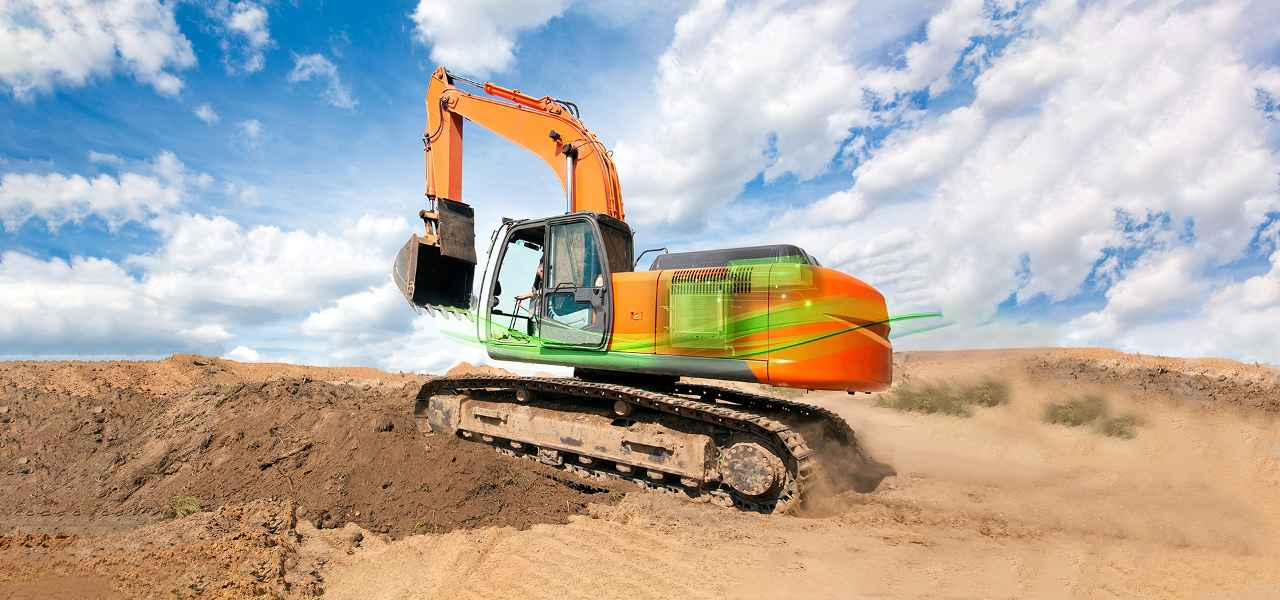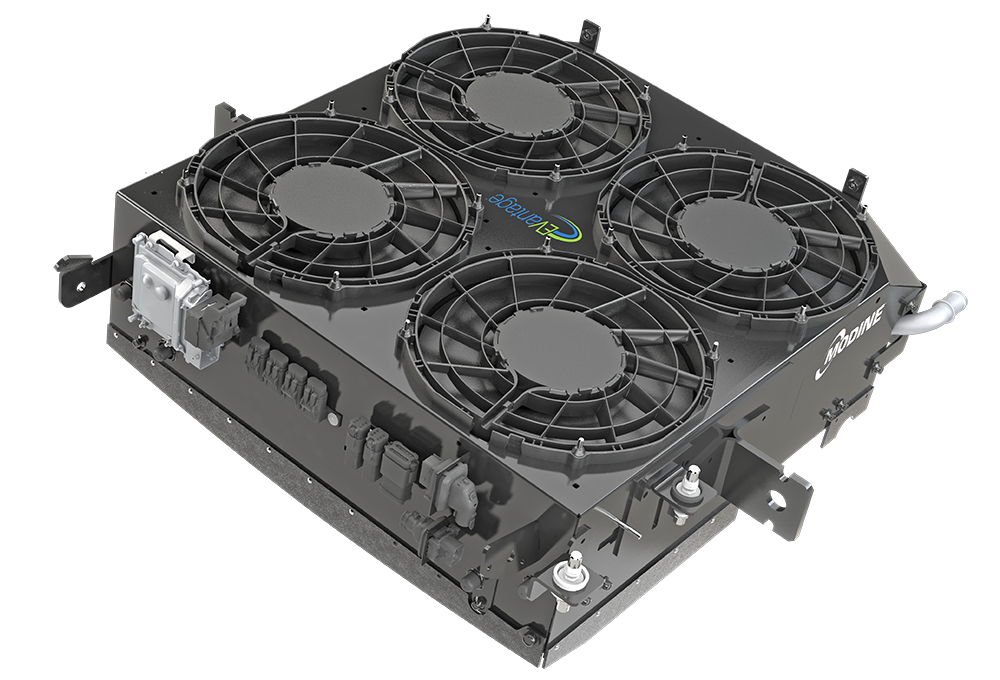 在为不同类型和功能的非公路电动车设计和布置热管理组件时,必须注重灵活性。(Modine)
在为不同类型和功能的非公路电动车设计和布置热管理组件时,必须注重灵活性。(Modine) 电子冷却组件 (ECP) 中的热交换器可防止因空气质量差或微粒含量高而造成的堵塞。(Modine)
电子冷却组件 (ECP) 中的热交换器可防止因空气质量差或微粒含量高而造成的堵塞。(Modine) ECP和BTMS是分开的,因此ECP可以放置在车辆上,以最大限度地减少灰尘侵入,而 BTMS(如图所示)则可以放置在底盘的任何位置。(Modine)
ECP和BTMS是分开的,因此ECP可以放置在车辆上,以最大限度地减少灰尘侵入,而 BTMS(如图所示)则可以放置在底盘的任何位置。(Modine) 本文由摩丁制造公司(Modine Manufacturing Company)电动车先进热管理系统副总裁兼总经理Gina Maria Bonini为SAE媒体撰写。
本文由摩丁制造公司(Modine Manufacturing Company)电动车先进热管理系统副总裁兼总经理Gina Maria Bonini为SAE媒体撰写。
摩丁制造公司(Modine)高管指出,与五年前内燃机汽车使用的技术相比,电动车热管理系统已经有了长足的发展。
仅仅几年前,电动车还很罕见,但如今,越来越多的人选择它成为自己的日常座驾。根据国际能源署的年度《Global EV Outlook》,仅在2024年第一季度,电动乘用车的销量就比2023年同期增长了25%左右。虽然乘用车市场的电动车普及率正在不断提高,但非公路车辆市场的电气化进程却仍然滞后。
坚固耐用的非公路车辆通常承担建筑和农业领域的重型作业,因此这些车辆工作负荷大且占空比高,导致其电气化进程缓慢。除了采用更大容量的电池、牵引电机和无数相关部件之外,非公路车辆的电气化还需要攻克大量难题,例如:满足续航里程要求、克服恶劣的环境条件,以及安装车队正常运营所需的充电基础设施等。而这些都会对产业链上下游各方造成影响。
从紧凑型叉车到大型工业起重机,各种非公路车辆都对空间设计有独特的限制要求。由于非公路市场正处于电气化的早期阶段,需求尚未成熟,但正在逐渐增长。因此,许多车辆制造商和终端用户选择将改装现有车辆作为开始电气化的第一步。然而,对内燃机平台进行电气化改装时需要兼顾创新与实用,这一点对电动车组件的有效散热尤为重要,因为这些组件不再位于中央散热器后面或底盘前部。
大型车辆的热管理系统设计也有类似的问题,但情况更加特殊。Modine与工程机械制造巨头小松(Komatsu)合作,将EVantage L-CON电池热管理系统(BTMS)集成至一辆20吨的电动挖掘机中,以优化其性能、延长使用使命并减少停机时间。由于该挖掘机空间充足,研发团队将BTMS集成至一个单箱单元中,显示了散热系统灵活性设计在非公路电动汽车中的价值。无论是微调还是全面定制设计,Modine热管理系统都能够适应任何尺寸的底盘,优化性能、延长使用寿命并提升效率。
相比之下,博世力士乐的滑移转向装载机可用于更小规模的日常施工项目中,而且可在一天结束后返回仓库,在温度较为理想的仓库充电站内进行夜间充电。在这种情况下,无需广泛采用预处理策略,就能使滑移转向装载机为第二天的工作做好准备。
不同于主要在铺装道路上行驶的传统乘用车和商用车,电动非公路机械经常需要在各种崎岖地形上工作。无论是建筑工地、农场还是矿山,这些车辆都必须能够适应极端环境,且性能不得受到影响。因此,这些电动机械的热管理系统也必须能够经受远超柏油路面的恶劣和脏乱环境的考验。
Modine利用两级系统设计了一款可置于底盘上任何位置的液冷冷凝器BTMS,并利用电子冷却套件(ECP)将热量散发到周围的空气中。ECP中的热交换器可用于防止因空气质量差或颗粒物含量高而引发的堵塞,这种情况在建筑工地等恶劣、脏乱的环境中经常出现。由于ECP和BTMS都是独立的设备,因此可通过合理布局ECP在车上的位置,以最大程度减少灰尘侵入,并将BTMS放置在底盘上任意合适的位置上。
为确保热管理系统设计能满足非公路应用中的各种极端工作条件,Modine将每一台热管理系统整合至对应的非公路车辆平台上,并在多种仿真环境中(风洞、气候室、测试振动的颠簸跑道等)开展全速运行的测试。严格测试是必不可少的,因为热管理系统与其他重要的实时车辆系统一样,必须能够承受恶劣的环境并保持正常运行。
A rarity only a few years ago, electric vehicles (EVs) are becoming part of the daily lives of constantly increasing numbers of drivers. In the first quarter of 2024 alone, passenger EV sales soared by about 25% compared to the same period in 2023, according to the IEA’s annual Global EV Outlook. While the passenger EV market charges ahead toward widespread adoption, the off-highway vehicle segment lags in electrification.
The burly and rugged workhorses that do the heavy lifting in construction and agriculture have been slower in embracing electrification due to their heavier workloads and duty cycles. In addition to larger batteries, traction motors and countless other components, the electrification of this class of vehicles also requires a steep learning curve, all of which impact stakeholders up and down the value chain. For example, navigating range requirements and harsh environmental conditions remain industry-wide challenges in electrifying off-highway machinery, as does installing the necessary infrastructure of chargers to keep the fleet running.
With over a century of expertise designing diesel and gasoline engine thermal systems, Modine now stands at the forefront of the transition to electricity as an off-highway vehicle fuel. Drawing on its experience in systematic approaches to either removing or adding heat in complex, high-availability, heavy-duty vehicles, Modine has been applying the lessons from its past challenges to build EV thermal management systems that cater to the unique needs of off-highway vehicles.
Right-sizing under design constraints
Vehicles ranging from compact forklifts to imposing industrial cranes have unique space constraints. Because the off-highway market is in the early days of electrification with nascent but growing demand, re-powering an existing vehicle has become an early play for vehicle manufacturers and end users to start the journey. However, re-powering an internal combustion engine (ICE) platform requires a delicate balance of innovation and practicality. This is particularly true when dealing with the challenge of reliably expelling the heat produced by EV components that no longer sit behind radiators centrally or at the front of the chassis.
For example, while developing a comprehensive thermal management system for an electric skid steer loader being electrified by Bosch Rexroth, Modine engineers had to reimagine the layout of the system to fit the confines of the already compact platform. To achieve this, the team designed a distributed system to maximize flexibility in placing thermal management components within the vehicle.
Working on larger vehicles presents a related yet unique set of challenges. Modine collaborated with industrial vehicle industry giant Komatsu to integrate the EVantage L-CON Battery Thermal Management System (BTMS) into a 20-ton electric excavator to optimize performance, extend longevity and reduce downtime. With ample space, the team integrated the BTMS into a single-box unit, underscoring the value of versatility in a thermal management system used in electric off-highway vehicles. From minor adaptations to fully customized designs, the ability to fit any chassis size ensures optimal performance, longevity and efficiency.
Preconditioning key to EV battery success
Off-highway vehicles, diverse in form and function, also require battery systems tailored to address the unique demands of each vehicle’s intended use and operating environment. Each EV lithium-ion battery pack has components highly dependent on cooling technology to mitigate the impact of temperature fluctuations. Unlike traditional ICE vehicles, where engine coolant temperatures can range from 85 to 215°C (185 to 419°F), EV batteries require a much narrower operating window of 20 to 45°C (68 to 113°F). To ensure optimal performance and maximize efficiency and longevity, EV battery preconditioning is a vital aspect of thermal management – and that holds true for everything from passenger cars to commercial vehicles to off-highway machines.
Preconditioning involves heating or cooling a vehicle’s battery to the optimal temperature so that it is ready for maximum operation, a process that is ideally done while the vehicle is connected to a charger. The Komatsu electric excavator, for example, can handle extended shifts and endure a variety of environmental conditions on a large construction site. However, these vehicles do not typically benefit from parking indoors during a project.
When left to charge outdoors overnight, the vehicle batteries risk becoming cold-soaked unless the vehicle is outfitted with a BTMS to keep the battery pack at optimal temperature through the night, avoiding compromised performance when the vehicle starts up in the morning. As such, construction managers must factor a preconditioning strategy into their deployment schedules, vehicle usage patterns and operational plans to ensure the vehicle’s overall success.
In comparison, the Bosch Rexroth skid steer loader might be deployed for more minor, day-to-day construction projects and returned to a depot at the end of the day. The machine can be plugged into a charging station in the depot warehouse, where the overnight temperature remains ideal for the battery. In this case, the skid loader requires a less extensive preconditioning strategy to ensure readiness for deployment the following day.
Adapting to rugged environments
Unlike conventional passenger and commercial vehicles primarily bound to paved roads, electric off-highway machinery must be ready to navigate a diverse range of rugged terrain. Whether on a construction site, farm or mine, these vehicles must endure extreme operating conditions – without compromising performance. In turn, the thermal management systems installed in these electric machines must withstand the harsh and dirty conditions beyond the tarmac.
By leveraging a two-stage system, Modine was able to design the liquid-cooled condenser BTMS to be placed anywhere on the chassis and use the Electronics Cooling Package (ECP) to reject heat to ambient air. The heat exchangers in the ECP are designed to resist clogging caused by poor air quality or high particulate levels, as found in harsh and dirty environments like a construction site. Since the ECP and BTMS are separated, the ECP can be strategically placed on the vehicle to minimize dirt intrusion, and the BTMS can be placed anywhere on the chassis for fit.
To ensure the thermal system design will meet the extreme conditions of off-highway applications, each thermal system is integrated into the corresponding off-highway vehicle platform and then run full-tilt in simulated environments from wind tunnels and climate chambers to the punishment of vibration testing on the rumble track. Rigorous testing must be standard practice. Like many other critical and real-time vehicle systems, thermal management systems must withstand harsh environments and remain operable.
Gina Maria Bonini, VP and general manager of advanced thermal systems for electric vehicles at Modine Manufacturing Company, wrote this article for SAE Media.
等级
打分
- 2分
- 4分
- 6分
- 8分
- 10分
平均分
- 作者:Gina Maria Bonini
- 行业:商用车
- 主题:制造质量、可靠性与耐久性工程设计与造型测试与检验
